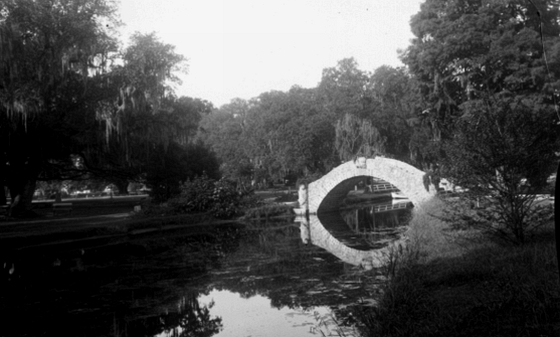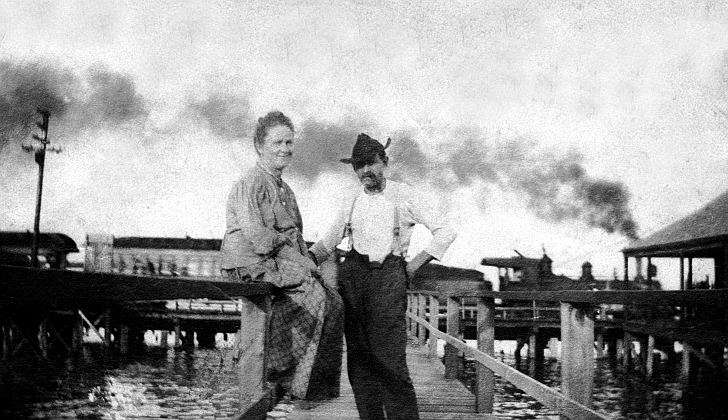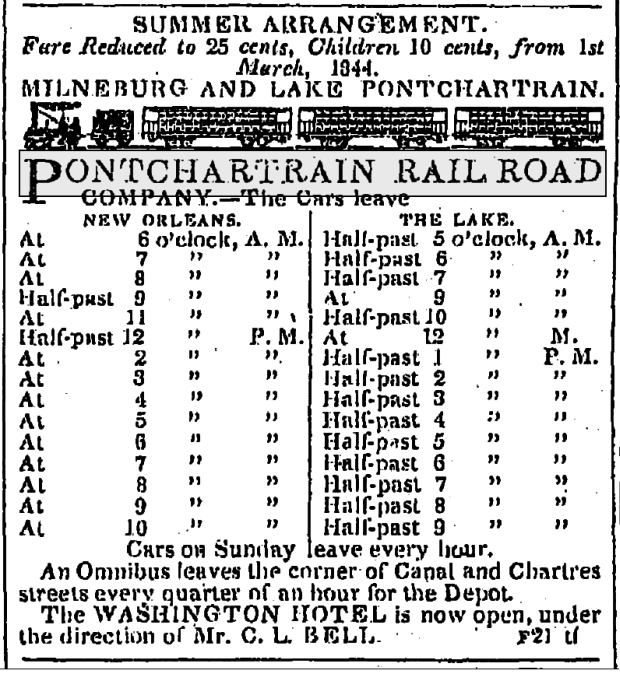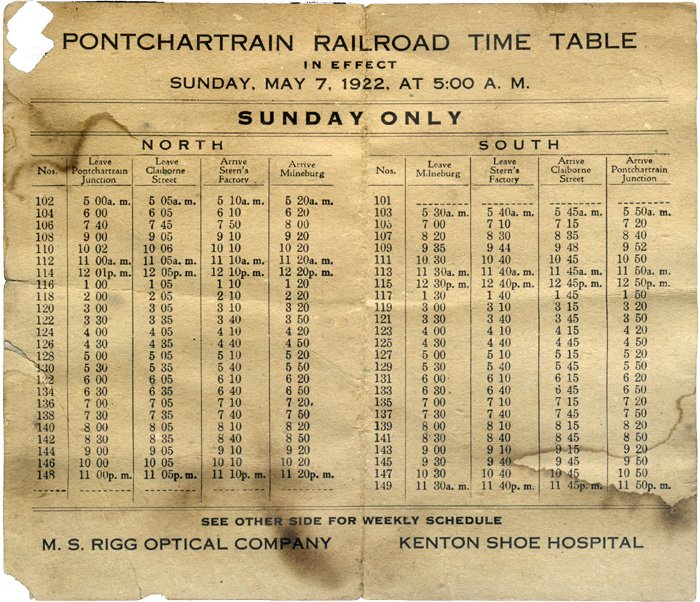
First Ride on the Zephyr
April 23, 1939
On April 23, 1939, the Zephyr first whisked New
Orleanians into the sky along its winding path around the park. Harry Jr. remembered, when he was a twelve year-old,
"It was fantastic to get on top of the Zephyr and see nothing but cow pasture as far as you could see in Gentilly".
The first Pontchartrain Beach opened in 1928,
across Bayou St. John from the old Spanish Fort on filled land newly reclaimed from the lake by the Orleans Levee Board.
The "Old Beach" featured a boardwalk, a bath house and rides. But the hard times of the Depression hit the new
amusement park hard, in spite of improvements (including a seawall to replace the boardwalk and a vehicular bridge over Bayou
St. John) made by the Batt family, which took over its operation in 1933. In 1938, when development (with the help of the
WPA) of Lake Vista began just next door, the Batts took advantage of the opportunity to move the park farther east along the
lakefront to Milneburg, and the "Old Beach" was demolished. This photograph of the entrance to the park was taken
on March 7, 1939, shortly before demolition began. (From the New Orleans Public Libary)
Before becoming involved in the amusement business, Harry
Batt, Sr., born in New Orleans on June 20, 1903, worked at Home Ice Company, founded in 1893 by his grandfather. His
father, John William Batt, had built the first ice manufacturing plant in New Orleans, according to Marquerite Batt, his
wife. Educated at Danneel Elementary and Warren Easton High School, he dropped out of high school after the first year to
help in the family business during WWI. He married Marguerite Spraul on September 2, 1924. When home refrigerators were becoming
popular appliances in the upper-class homes in the areas serviced by Harry (University Section near Tulane and Newcomb Colleges),
he foresaw a decline in his business and began to entertain the thought of entertainment as a career. In 1927 he met
and befriended the merry-go-round operator at Audubon Park whose business was already suffering. Harry and his father
invested an interest in this small endeavor. Harry's interest was peaked. A neighbor owned arcade equipment -- he and
Harry leased the newly created lakefront land in front of what would become Lake Vista and opened an arcade there under the
corporate name of Playland Amusements, of which his father was also an investor. The seawall had yet to be built but
a wooden boardwalk was in place as well as a bathhouse and other facilities owned by Lakeshore Amusement Company. Playland
owned and installed rides there on pilings. The park opened in 1928. In 1930 Harry became Playland's general manager
and his father was no longer active in the business. In 1931, Dorothy Lamour was crowned Miss New Orleans there before becoming
a top movie star. Lakeshore Amusements fell on hard times and in 1934 Playland successfully bid to become the sole operator
of the park. "We never intended to [take it over], but when the Depression hit and the company which ran the park folded
we took over", said Harry. The business was named Pontchartrain Beach.
In 1938 a vehicular bridge was built over Bayou St. John, residential development of Lake Vista began, and
Playland, Incorporated a well as Pontchartrain Beach moved to a 50 acres site in front of what was the town of Milneburg.
The "Bug" was transported to the new location and used until the last day, September 6, 1983. Harry's father,
who died shortly after the move, told him, "You'll never make it. You put too much money into this"
but it lasted 45 years until "the beach" closed in 1983. During the early days of the park at the end of
Elysian Fields Avenue, Marguerite worked hard filling in at any positions which needed help. The family with two young
sons, Harry Jr. and John, lived in town until Harry converted an old bathhouse into an apartment in which they lived for
22 years (until moving to Lake Terrace shortly before Harry retired in 1970) -- Marguerite said, "It was like living
in a big, posh estate". Harry Jr. and John worked in the family business as boys, doing everything from manning
the snowball shack to counting money.
Harry's hands-on management style led him to personally hire many of the famous animal
acts, magicians, tight-rope walkers, high-diver, daredevils, and entertainers. He introduced fire-works shows and dolphin
acts. He hired celebrity guests including Lex Barker (the screen's Tarzan), Rudy Valee, Roy Rogers, Walter Pidgeon, Mike Douglas,
and a very young Elvis Presley whose advertising and entertainment bill was topped by an animal act. Harry sponsored many
charity events at his venue but his favorite thing to do at the beach was to host beauty pageants. "If there was
anything I loved, it was a beauty contest", he said. Sharon Brown and Euyne Howell went on to become Miss USAs.
The beach also hosted the Miss Louisiana pageant.
Kiddieland opened
in 1947, surrounding the historic Milneburg/Port Pontchartrain light house. Bali Hai began serving Polynesian food in
1958, closing in 1975 with the exception of private catering functions. 1964 brought the introduction of POP (pay-one-price)
Days but the attendance fell to an all-time low from 1964 through 1969. Harry Jr. and John added a new sky ride and
the Calypso. In 1978 the $1.3 million Rajun Cajun was the last ride installed at the beach.
Harry Batt, Sr., retired in 1970 as president and managing director of Pontchartrain Beach, and Harry Batt,
Jr., and his brother, John Batt, served as President, and Vice President, respectively, until the lakefront park closed.
Well known and respected in the amusement industry, Harry Sr. was a co-director of the 1962 Seattle World's Fair and
directed the installation of a model railroad at St. Louis Zoo in 1963. He was a member of the International Association
of Amusement Parks and Attractions. At home he helped organize the New Orleans Recreation Department, was instrumental in
establishing a burn center at Charity Hospital, and was active in raising funds for victims of multiple sclerosis, the Crippled
Children's Hospital, and the New Orleans Council of Jewish Women. He was a member of International House, New Orleans
Chamber of Commerce education committee, Housing Authority of New Orleans, Salvation Army, and Variety Clubs International.
Mr. Batt was chairman of the board of managers of Delgado Museum (now
New Orleans Museum of Art), director of the National American Bank, was honored in 1976 by the Young Men's Business Club
for the annual outing he sponsored for poor children at his amusement park, received the Outstanding Citizen of the Year
Award from the art museum in 1976, and reigned as king of the Louisiana Society of the Washington Mardi Gras ball in 1972.
Harry Batt Sr. died of a heart attack during a trip to Hong Kong with his beloved Marguerite on November 5, 1977 at the age
of 74.
Related reading: Lake Pontchartrain (Images of America) by Catherine Campanella
You Can Support this Site by Clicking on & Shopping from this Amazon Link -- and it
won't cost you a penny more:


On April 23, 2008, Katrina "Recovery Czar", Edward Blakely, announced that
he received a proposal to bring back the hurricane damaged Jazzland/Six Flags amusement park in New Orleans East from Danny
Rogers of the unincorporated Bay St. Louis based Southern Star Amusement Group. According to Blakely, a letter
of commitment from Six Flags Inc. vice president William Prip was included in the $70,000,000 proposal which would include
a water park and double the number of rides. The plan also includes a ligh-rail system, five additional entertainment
areas, an RV park.
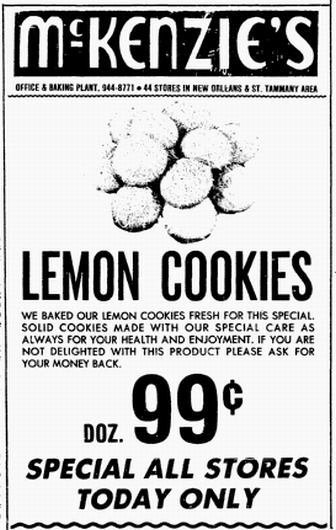 April 23, 1983
April 23, 1983 advertisement for McKenzie's Lemon Cookies. At that time, McKenzie's Bakery owned 44
stores in the greater New Orleans area.
On April 23, 1909, the New Orleans Times-Democrat reported, "Death Comes After
Long Illness of Complication of Diseases--Passes Away at His Home--Had Been Steamboat Captain and Wholesale Grocer.
News was received here yesterday of the death of John T. Moore at 2 o'clock in the afternoon on his plantation, "Waubun,"
near Shriever, La. John T. Moore was prominently known in this city and in South Louisiana as a merchant and planter and
a gentleman of high character and integrity. He was a native of St. Louis, where he was born in 1838. When quite
young he came to New Orleans, and at one time was a steamboat captain, having commanded the steamboat Ida Handy. Later
he was engaged in the wholesale grocery business with John T. Moore, who bore the same name as himself, but was not
related to him. For a number of years the firm of John T. Moore & Co. did a successful business. Later in life he
engaged in sugar planting and during the last few years had lived on his plantation. Death was due to complications of
Bright's disease and was not unexpected, as he had been sick for quite a while. Many years ago he married the daughter
of his partner in business, Miss Julia Moore, who survives with a number of children, who are Mrs. Frank W. Harrison,
Charles V. Moore of Schriever, Miss Julia Moore, Mrs. Cleon M. Freret, Mrs. Anna Roger of Thibodaux, Joseph A. Moore
and Mrs. C. A. Lelong. The body will be brought to this city and upon the arrival of the 11:40 train of the Southern Pacific
Railway will be taken to the Jesuit's Church, where the funeral will be conducted".
This bridge in City Park was built with a donation by Angele Langles. Her
memorial in Metairie Cemetery (pictured in the center, below) is marked only with “Angele Marie Langles – 105
LA 39”. Angele and her widowed mother Paulina Costa Langles were lost at sea in the North Atlantic on July 4, 1898
aboard the French steamship La Bourgogne which had left New York for La Havre, France two days prior. The ship was broadsided
in heavy fog by the ironclad British sailing ship Clomartyshire. Both mother and daughter had willed their considerable fortune
to one another. Family members contested the wills but begrudgingly and by court order erected the monument. “105 LA
39” is the docket number of the Supreme Court of Louisiana decision on April 23, 1900 which mandated
that the monument be built with funds from the estate. (Photos from the Louisiana Digital Library. Text from New Orleans City Park (Arcadia Publishing by Catherine Campanella.)
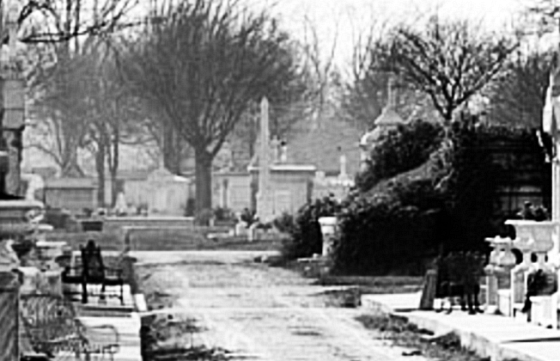
Charlotte Saunders Cushman, actress. Born, Boston, Mass., July 23, 1816; daughter of Elkanah Cushman
and Mary Eliza Babbitt. Studied opera; debut, Boston, Tremont Theatre, April 8, 1835, as Countess Almaviva in The Marriage
of Figaro. Went with Clara Fisher Company to New Orleans; member of the company at the St. Charles Theatre during the 1835-1836
season; appeared in operas to bad reviews. James H. Caldwell (q.v.), manager of the St. Charles Theatre, encouraged her
to develop her dramatic talents and to abandon singing which she was willing to do. Dramatic debut, New Orleans, St. Charles
Theatre, April 23, 1836, as Lady Macbeth; marked the beginning of her successful career as a dramatic actress.
Noted here and abroad in such roles as Meg Merriliers in Guy Mannering, Nancy Sykes in Oliver Twist, and Queen Katharine
in Henry VIII. Essayed male roles: Romeo, Wolsey, Hamlet. Made frequent "farewell" tours as health declined.
Described as the most powerful American actress of the nineteenth century. Never married. Died, Boston, February 17,
1876; interred Mount Auburn Cemetery, Cambridge, Mass. From http://lahistory.org/site20.php
First Ride on the Smokey Mary
April 23, 1831
Theresa
Gallagher and her second husband Conrad Freese pose on the front walk of a camp in Milneburg
c. 1880 - 1890.
The Pontchartrain Railroad’s “Smokey Mary”
can be seen in the background. (Photo courtesy of Henry Harmison.)
The Pontchartrain Rail-Road
was an early railway, chartered in 1830, which began transporting people and goods between the Mississippi River front and
Lake Pontchartrain on April 23, 1831, and closed more than 100 years later. The 5-mile long line
on Elysian Fields Avenue connected the Faubourg Marigny along the riverfront with the town of Milneburg on the Lakefront.
When built, the majority of the route ran through farmland, woods, and swamp. Meetings discussing building a railway
began in 1828. The Pontchartrain Rail-Road was chartered on January 20, 1830. The right-of-way was approved by the New
Orleans City Council on March 15, and construction began immediately, with a pair of parallel railroad tracks. Through
swampland, up to 4 feet of fill was needed to create a sufficient road bed. A 150 foot wide bed was constructed along
the entire route, with the rail line laid with red cypress timbers and English rolled iron rails. Construction of the line
was completed on April 14, 1831, and it officially opened on April 23rd, with horse drawn railway carriages. The first
steam locomotive, "the Shields", was built by John Shields and arrived from Cincinnatti by steamer
on June 15, 1832. This first locomotive proved unreliable; the company even tried
using sails to help propell the train.
A second locomotive "the Pontchartrain" built by Rothwell, Hicks,
and Rothwell arrived in September, was tested on September 6. It proved
better, allowing the line to advertise regular steam service of 7 round trips per day (9 on Sundays) starting on September
27, 1832. "The Shields" was cannibalized, the boiler used to run equipment at the railroad's machine shop. "The
Pontchartrain" as well as succeeding locomotives
became known as the famous and beloved "Smokey Mary". It was comprised of an
"engine car" (with the power of 24 horses) and
12 passenger/cargo cars.
Saturday, August 17, 1844
Schedule
"When put to the test, Smoky Mary could,
amidst great puffing and blowing and much expulsion of smoke and cinders, attain the remarkable speed of ten miles
an hour. Passengers usually emerged with clothes blackened and eyes and throat stuffed with cinders" from [GumboYa-Ya]. The line was the first in the world to include a freight landing platform. Milneburg had no jail but the train had a prison car -- rowdies
were loaded throughout the day and night into the car which was hooked to
the train for its last run of the night to transport the captives
to Parish Prison in the city. Passenger service on the Pontchartrain
Railroad, one of the nation’s oldest lines, ended after a century of servic on March 15, 1932, when Smokey Mary
made a final trip from Milneburg -- three coaches packed with riders led by John A. Galivan,
engineer during a third ( 32 years) of
the railroad's history.
A 1922 Pontchartrain Railroad Schedule








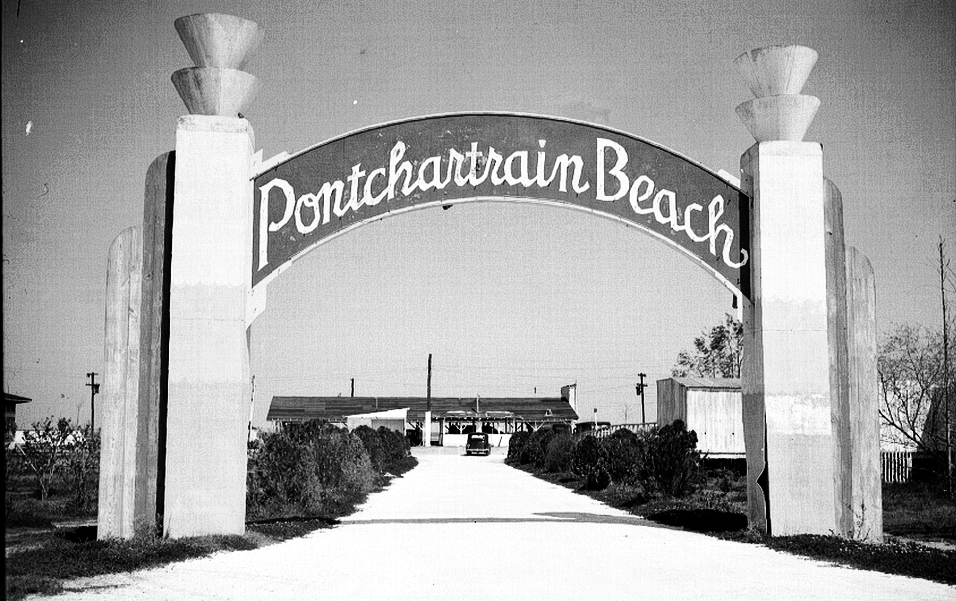
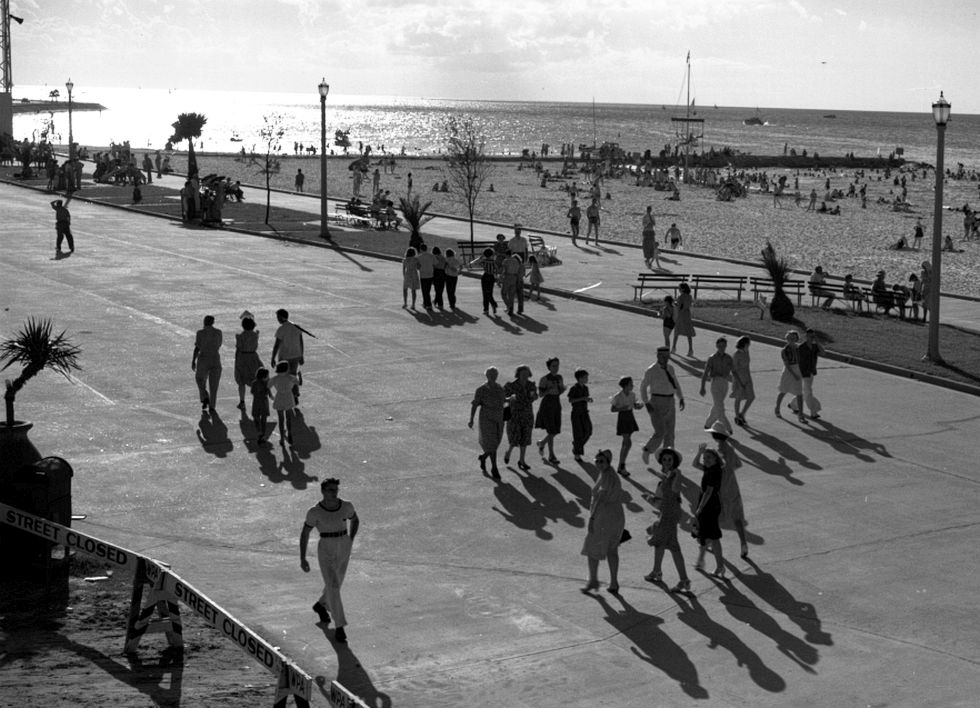
 April 23, 1983 advertisement for McKenzie's Lemon Cookies. At that time, McKenzie's Bakery owned 44
stores in the greater New Orleans area.
April 23, 1983 advertisement for McKenzie's Lemon Cookies. At that time, McKenzie's Bakery owned 44
stores in the greater New Orleans area.